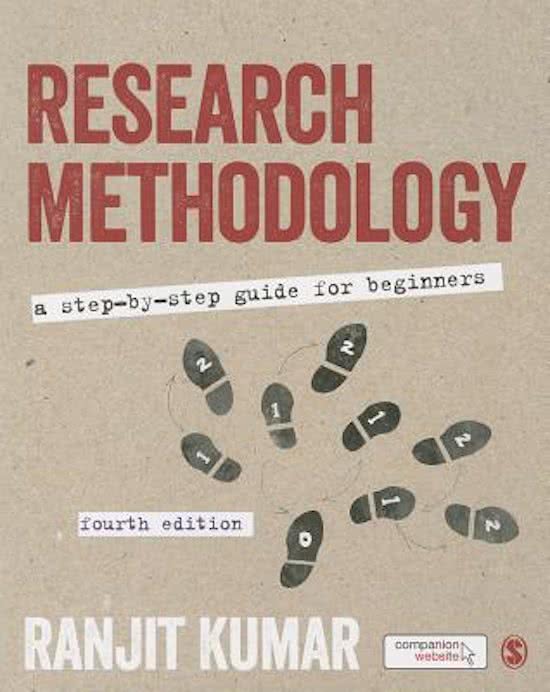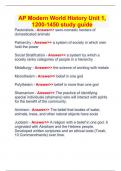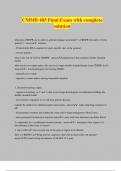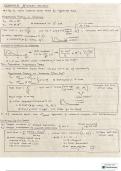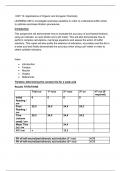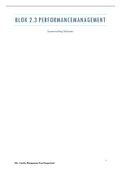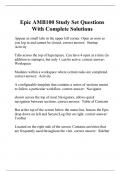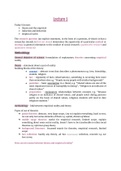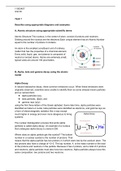Summarized by Judith de Heus
Research Methodology by Ranjit Kumar
Chapter 1: Research: a way of thinking
Research is to look at your practice or work situation inquisitively, critically, and analytically
to gain an in-depth knowledge of its rationale, relevance, effectiveness, and efficiency.
Research develops in your way of thinking logical and rational, and it encourages you to
critically examine aspects of your day-to-day situation.
Research is an integral part of good professional practice and is responsible for influencing
the practice procedures and outcomes in these professions. Among many professions,
practice relies heavily upon what is discovered through research (medicine, public health,
psychology, and education). The greater the integration between research and practice, the
greater advancement in its theoretical and practice knowledge base.
Evidence-based practice (EBP) is the delivery of services based upon research evidence
about their effectiveness; the server provider's clinical judgment as to the suitability and
appropriateness of the service for a client; and the client's own preference as to the
acceptance of the service. This concept encourages professionals and other decision-makers
to use evidence regarding the effectiveness of an intervention, with the characteristics and
circumstances of a client to determine the appropriateness of an intervention when
providing a service to a client.
Research is to collect accurate, sound, and reliable information about the effectiveness of
interventions (proved by evidence of the effectiveness). The validity of your findings
depends on the soundness of the research methods and procedures you adopt. The
application of research can be viewed from four different perspectives:
1. the service provider;
2. the service administrator, manager and/or planner;
3. the service consumer; and
4. the professional.
Research is to find answers to your research questions. When you undertake a research
study to find answers to a question, you are implying that the process being applied:
1. is being undertaken within a framework of a set of philosophies;
2. uses procedures, methods, and techniques that have been tested for their validity
and reliability; and
3. is designed to be unbiased and objective.
The philosophical orientation may be based on several paradigms and approaches: positivist,
interpretive, phenomenology, action or participatory, feminist, qualitative, quantitative, and
mixed methods. Validity ensures that correct procedures have been applied to find answers
to a question. Reliability refers to the quality of a measurement procedure that provides
repeatability and accuracy. Subjectivity is an integral part of your way of thinking that is
conditioned by your educational background, academic discipline, philosophy, experience,
and skills. Bias is a deliberate attempt to either conceal or highlight something because of
your vested interest.
, Summarized by Judith de Heus
Research between different disciplines can vary much. Therefore, the research model is
based upon a broad approach to enquiry. Research is a process of for collecting, analyzing,
and interpreting information to answer research questions. The process must have certain
characteristics and fulfil some requirements:
• Controlled: it is important to design a study in such a way that enables you to link
cause(s) with the effect(s) and vice versa. Also, it is important to isolate the effect of
all other factors that are of no interest to you as a researcher but have an influence
on the outcomes.
• Rigorous: it is important to find answers to questions that are relevant, appropriate,
and justified.
• Systematic: this implies that the procedures follow a certain logical sequence.
• Valid and verifiable: this implies that whatever you conclude on the basis of your
findings is correct and can be verified by you and others.
• Empirical: any conclusions drawn are based upon hard evidence gathered from
information collected from real-life experiences or observations.
• Critical: foolproof and free from any drawbacks.
The three perspectives that form the basis of research classification are the following. They
can be classified from different perspectives in the same research study.
1. Applications of the findings of the research study: there are two broad categories:
pure research and applied research. Pure research involves developing and testing
theories and hypotheses that are intellectually challenging to the researcher but may
or may not have practical application at the present time or in the future. It is also
concerned with the development, examination, verification, and refinement of
research methods, procedures, techniques, and tools that form the body of research
methodology.
2. Objectives of the study:
a. Descriptive study attempts to describe systematically a situation, problem,
phenomenon, service or program, or provides information about, for
example, the living conditions of a community, or describes attitudes towards
an issue.
b. Correlational study is to discover or establish the existence of a relationship,
association, or interdependence between two or more aspects of a situation
or phenomenon.
c. Explanatory research attempts to clarify why and how there is a relationship
between two aspects of a situation or phenomenon.
d. Exploratory research is when a study is undertaken with the objective wither
or exploring an area where little is known or of investigating the possibilities
of undertaking a particular research study. Feasibility study / pilot study is
usually carried out when a researcher wants to explore areas about which the
person has little or no knowledge.
3. Mode of enquiry used in conducting the study:
a. Quantitative or structured approach: everything is predetermined.
b. Qualitative or unstructured approach.
, Summarized by Judith de Heus
c. Mixed methods approach: makes use of both quantitative and qualitative
research. It aims to select the best methods to find answers to the research
questions.
The choice between the quantitative, qualitative, and mixed methods approaches should
depend upon:
• The aim of your enquiry: exploration, confirmation, or quantification;
• The use of your findings: policy formulation or process understanding.
The main use of statistics is to act as a test to confirm or contradict the conclusions that you
have drawn on the basis of your understanding of analyzed data. Statistics help to quantify
the magnitude of an association or relationship, provide an indication of the confidence you
can place in your findings, and help you to isolate the effect of different variables. It is
strongly recommended that you do not lock yourself into becoming solely a quantitative or
qualitative researcher, because neither one is superior to the other.
The mixed multiple methods approach has been used more during the past few years.
Mixed methods refer to the approach to social enquiry that uses two or more methods,
processes, and philosophies in undertaking a research study. It is based upon the belief that
different paradigms and methods have different strengths.
Collecting data means to use different methods for information gathering. Different samples
refers to different groups of people drawn from the same study population. Data analysis
and information dissemination means to analyze data with quantitative and qualitative
techniques to best achieve the objectives of a study.
The use of the mixed methods approach is primarily based upon two beliefs: 1) the ability of
the methods of a paradigm to provide accurate answers to all your research questions in all
situations, and 2) the use of more than one method in most situations will provide a better
and more complete picture of a situation or phenomenon than a single method alone.
When to use the mixed methods approach:
• When you want to explore from both perspectives: qualitative and quantitative
research.
• When accurate and complete information from one source is difficult to obtain.
• A must for good quality research.
• When you need to make generalizations.
• When you need to find an explanation for your findings.
• When you want to develop a good data collection instrument and ascertain the
validity of the questions.
• When you undertake studies with multiple objectives.
There are several ways in which you can mix methods and procedures belonging to
quantitative and/or qualitative paradigms in mixed or multiple methods studies. It all
depends on what is being mixed (one or two paradigms), when the mixing is done (for the
entire process or for a part of it), in what stage of the research process the mixing takes
place (for the whole process of for one or some operational steps), in what order the mixing
Research Methodology by Ranjit Kumar
Chapter 1: Research: a way of thinking
Research is to look at your practice or work situation inquisitively, critically, and analytically
to gain an in-depth knowledge of its rationale, relevance, effectiveness, and efficiency.
Research develops in your way of thinking logical and rational, and it encourages you to
critically examine aspects of your day-to-day situation.
Research is an integral part of good professional practice and is responsible for influencing
the practice procedures and outcomes in these professions. Among many professions,
practice relies heavily upon what is discovered through research (medicine, public health,
psychology, and education). The greater the integration between research and practice, the
greater advancement in its theoretical and practice knowledge base.
Evidence-based practice (EBP) is the delivery of services based upon research evidence
about their effectiveness; the server provider's clinical judgment as to the suitability and
appropriateness of the service for a client; and the client's own preference as to the
acceptance of the service. This concept encourages professionals and other decision-makers
to use evidence regarding the effectiveness of an intervention, with the characteristics and
circumstances of a client to determine the appropriateness of an intervention when
providing a service to a client.
Research is to collect accurate, sound, and reliable information about the effectiveness of
interventions (proved by evidence of the effectiveness). The validity of your findings
depends on the soundness of the research methods and procedures you adopt. The
application of research can be viewed from four different perspectives:
1. the service provider;
2. the service administrator, manager and/or planner;
3. the service consumer; and
4. the professional.
Research is to find answers to your research questions. When you undertake a research
study to find answers to a question, you are implying that the process being applied:
1. is being undertaken within a framework of a set of philosophies;
2. uses procedures, methods, and techniques that have been tested for their validity
and reliability; and
3. is designed to be unbiased and objective.
The philosophical orientation may be based on several paradigms and approaches: positivist,
interpretive, phenomenology, action or participatory, feminist, qualitative, quantitative, and
mixed methods. Validity ensures that correct procedures have been applied to find answers
to a question. Reliability refers to the quality of a measurement procedure that provides
repeatability and accuracy. Subjectivity is an integral part of your way of thinking that is
conditioned by your educational background, academic discipline, philosophy, experience,
and skills. Bias is a deliberate attempt to either conceal or highlight something because of
your vested interest.
, Summarized by Judith de Heus
Research between different disciplines can vary much. Therefore, the research model is
based upon a broad approach to enquiry. Research is a process of for collecting, analyzing,
and interpreting information to answer research questions. The process must have certain
characteristics and fulfil some requirements:
• Controlled: it is important to design a study in such a way that enables you to link
cause(s) with the effect(s) and vice versa. Also, it is important to isolate the effect of
all other factors that are of no interest to you as a researcher but have an influence
on the outcomes.
• Rigorous: it is important to find answers to questions that are relevant, appropriate,
and justified.
• Systematic: this implies that the procedures follow a certain logical sequence.
• Valid and verifiable: this implies that whatever you conclude on the basis of your
findings is correct and can be verified by you and others.
• Empirical: any conclusions drawn are based upon hard evidence gathered from
information collected from real-life experiences or observations.
• Critical: foolproof and free from any drawbacks.
The three perspectives that form the basis of research classification are the following. They
can be classified from different perspectives in the same research study.
1. Applications of the findings of the research study: there are two broad categories:
pure research and applied research. Pure research involves developing and testing
theories and hypotheses that are intellectually challenging to the researcher but may
or may not have practical application at the present time or in the future. It is also
concerned with the development, examination, verification, and refinement of
research methods, procedures, techniques, and tools that form the body of research
methodology.
2. Objectives of the study:
a. Descriptive study attempts to describe systematically a situation, problem,
phenomenon, service or program, or provides information about, for
example, the living conditions of a community, or describes attitudes towards
an issue.
b. Correlational study is to discover or establish the existence of a relationship,
association, or interdependence between two or more aspects of a situation
or phenomenon.
c. Explanatory research attempts to clarify why and how there is a relationship
between two aspects of a situation or phenomenon.
d. Exploratory research is when a study is undertaken with the objective wither
or exploring an area where little is known or of investigating the possibilities
of undertaking a particular research study. Feasibility study / pilot study is
usually carried out when a researcher wants to explore areas about which the
person has little or no knowledge.
3. Mode of enquiry used in conducting the study:
a. Quantitative or structured approach: everything is predetermined.
b. Qualitative or unstructured approach.
, Summarized by Judith de Heus
c. Mixed methods approach: makes use of both quantitative and qualitative
research. It aims to select the best methods to find answers to the research
questions.
The choice between the quantitative, qualitative, and mixed methods approaches should
depend upon:
• The aim of your enquiry: exploration, confirmation, or quantification;
• The use of your findings: policy formulation or process understanding.
The main use of statistics is to act as a test to confirm or contradict the conclusions that you
have drawn on the basis of your understanding of analyzed data. Statistics help to quantify
the magnitude of an association or relationship, provide an indication of the confidence you
can place in your findings, and help you to isolate the effect of different variables. It is
strongly recommended that you do not lock yourself into becoming solely a quantitative or
qualitative researcher, because neither one is superior to the other.
The mixed multiple methods approach has been used more during the past few years.
Mixed methods refer to the approach to social enquiry that uses two or more methods,
processes, and philosophies in undertaking a research study. It is based upon the belief that
different paradigms and methods have different strengths.
Collecting data means to use different methods for information gathering. Different samples
refers to different groups of people drawn from the same study population. Data analysis
and information dissemination means to analyze data with quantitative and qualitative
techniques to best achieve the objectives of a study.
The use of the mixed methods approach is primarily based upon two beliefs: 1) the ability of
the methods of a paradigm to provide accurate answers to all your research questions in all
situations, and 2) the use of more than one method in most situations will provide a better
and more complete picture of a situation or phenomenon than a single method alone.
When to use the mixed methods approach:
• When you want to explore from both perspectives: qualitative and quantitative
research.
• When accurate and complete information from one source is difficult to obtain.
• A must for good quality research.
• When you need to make generalizations.
• When you need to find an explanation for your findings.
• When you want to develop a good data collection instrument and ascertain the
validity of the questions.
• When you undertake studies with multiple objectives.
There are several ways in which you can mix methods and procedures belonging to
quantitative and/or qualitative paradigms in mixed or multiple methods studies. It all
depends on what is being mixed (one or two paradigms), when the mixing is done (for the
entire process or for a part of it), in what stage of the research process the mixing takes
place (for the whole process of for one or some operational steps), in what order the mixing

